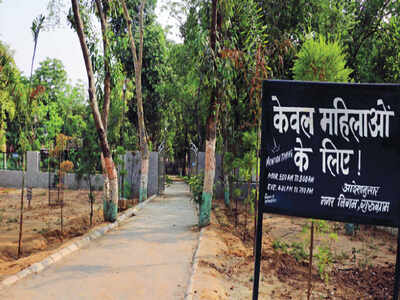
Last month, a park in the city turned ‘women only’, shutting out men from a common area that some ruffians had turned into a haunt. At a time when cities are trying to make public spaces more inclusive, this was a step in the other direction, but necessary because local residents received no guarantee of safety from the administration or police. The decision has started a debate around public spaces — some see the gender bar as retrograde while others feel it was an empowering step. Certainly, women residents of the neighbourhood were overwhelmingly in favour. And given that security remains a concern, this may not be the only park that turns gender-exclusive. Sharad Kohli reports
In May, the residents’ welfare association of Sector 10A in Gurugram took the unusual step of admitting only women to a neighbourhood park, following an incident of molestation there.
Of late, gender-restrictive parks have sprung up in places like Bhopal and Meerut, an unfortunate reflection of how unsafe some of our cities and towns have become. While there are supporters of the concept of exclusive spaces, many also question whether such a move might not come in the way of the spontaneity that is the essence of life, and of everyday communication between men and women.
Yet, for at least half the lifespan of the Delhi Metro, the first coach has been reserved for women. Pink autos have been running, with varying levels of frequency (and success) across much of Delhi-NCR for some time. And soon, Gurugaman, the service run by Gurugram Metropolitan City Bus Ltd, will introduce special buses for women during peak hours. Do gender-exclusive public spaces, or infrastructure, then, point to a failure of city authorities to guarantee the safety of women?
And when women and men are working on the same office or factory floor, when boys and girls are attending co-ed schools, or going to the same classes in college, is there any logic behind setting aside recreational spaces for only one gender? “It’s a wrong decision,” K C Kush, chief urban planner (retired), tells TOI.
“Why can’t they make the park safe?” asks Nilesh Tandon, secretary, Fresco Apartments RWA. “It’s unfair, because we’re living in the 21st century. “Otherwise, what is the need of co-education institutes? By this logic, there should be separate offices for women and men!”
Dr Kalpana Viswanath, co-founder of Safetipin, says creating women-only spaces does not address the problem in the long run. “You can have one or two women-only parks, but that cannot be the solution – it’s only a small part of the solution,” she contends. “Are we saying that it is not possible for Indian men and women to interact normally?”
The Safety Worry
Gurugram doesn’t have a Central Park or a Hyde Park but it does have the Tau Devi Lal and Leisure Valley parks. It also boasts the Aravali Biodiversity Park, once a mining site, and in a state of ruin not even 10 years back, but today a habitat for many species of plants and shrubs. Besides, there are around 600 parks scattered across the sectors in the old city, and in the colonies of New Gurugram. Some are well maintained, others less so (a fair few are in various states of disrepair).
Still, security is an issue crying out for attention, and not just in Gurugram’s parks. Manjju Banduni, ex-president of Luxotica RWA, says she understands the logic behind the decision. “They’ve obviously had to take action because of incidents. You want to go out for a walk, or visit the park, in the evenings, but it’s not safe. You can’t think of Gurugram as a place for walking or cycling, because of a lack of safety. And this is more so for women. So, looking at it in that light, this is the right step, I support it 100%.”
However, Dr Prabh Bedi, who heads the planning programmes in Sushant School of Planning and Development at Ansal University, disagrees. She sees this more as a stopgap arrangement than a solution, a measure that goes against the spirit of inclusivity. “It cannot be inclusive if you are excluding somebody,” she says. “The place needs to be made safe and more accessible to the public — because the eyes of the public are the best watch on things.”
Rights vs Welfare
Access to a park or any public space involves basic rights of citizens. “In any sector developed by Huda (now HSVP), all common areas and public places, whether it be a park, dispensary or community centre, are open to residents of the sector, and those from nearby areas,” explains Kush. “Plot holders and owners have contributed to the cost of land that houses community buildings and facilities, roads and open spaces, to run and maintain the services. So, how can one group be disallowed from using these services?” he asks.
Kush feels alternatives should have been considered. “If the RWA had any doubts or concerns, then it can utilise its funds to make arrangements for increased security or extra lighting,” he suggests.
Tandon believes more resources should go into making sure that safety of women is not compromised, adding kneejerk reactions only play into the hands of troublemakers. “This is actually sending the wrong signals to the anti-social elements, that we can’t guarantee the safety of women so we’ve made a separate park for them,” he argues.
Ultimately, the administration must carry the can for this state of affairs. “If the authorities so desire, they can ensure safety in the city,” reasons Banduni. “Why do you have to take your car out for a distance that takes only five minutes to cover? Because it isn’t safe to walk,” she adds.
What’s the way forward?
It’s a problem that needs to be tackled at many levels. “We can have some women-only spaces, I’m not against it, but along with that, we have to improve all public spaces. At the other level, we have to address social and cultural norms which allow masculinity to be expressed like this,” infers Safetipin’s Viswanath.
Also, there needs to be effective policing. “If a woman is walking in the park, and a guy is following her regularly, maybe some plainclothes policemen can come to the park at those times and nab the guy,” she adds. “It’s also very effective if you catch a few of them in front of other guys – then they get scared. The reason a lot of this happens is because these guys know they can get away with it.”
As things stand now in the city, though, more public spaces could become gender-restrictive or exclusive, if safety continues to remain a concern. “You have to work at making the city safe if you don’t want such a step to be taken,” says Banduni. “But the security scenario in Sector 10, on the other side of the highway, is especially bad – even if women wanted to venture out, they won’t be able to. And if the situation persists, then we too will be forced to take this step in our area.”
That is the dilemma that continues to confront public spaces, and their keepers, in Gurugram.
World Cup 2019
Trending Topics
LATEST VIDEOS
More from TOI
Navbharat Times
Featured Today in Travel
Quick Links
Lok Sabha Election Schedule 2019Lok Sabha Election NewsDelhi Capitals teamMI team 2019Rajasthan Royals 2019RCB team 2019Maharashtra Lok Sabha ConstituenciesBJP Candidate ListBJP List 2019 TamilnaduShiv Sena List 2019AP BJP List 2019Mamata BanerjeeBJP List 2019 MaharashtraPriyanka GandhiBJP List 2019 KarnatakaAMMK Candidate List 2019BJP List 2019 WBLok Sabha Elections in Tamil NaduBSP List 2019 UPNews in TamilLok Sabha Poll 2019Satta Matka 2018PM ModiMahagathbandhanNagpur BJP Candidate ListChandrababu NaiduTamil Nadu ElectionsUrmila MatondkarNews in TeluguMadras High CourtTejashwi YadavArvind KejriwalTejasvi SuryaPawan KalyanArvind KejriwalYogi AdityanathJaya PradaSatta King 2019Srinagar encounter
Get the app







